Do you own a 1909 Lincoln VDB penny and wonder how much it is worth?
This coin has generated a lot of buzz over the years, and for good reason. Its release was quite controversial, to the point that the U.S. Mint had to halt production and make design changes before reissuing it into circulation.
In this article, we’ll explore the current market value of the 1909 VDB penny. You’ll learn about its history, unique characteristics, and, most importantly, how much it might be worth today.
Some error variations can be worth hundreds—or even thousands—of dollars, depending on their rarity and condition.
So, without further ado, let’s dive into the details of this iconic and controversial 1909 Lincoln penny.
1909 VDB Penny Value Chart
| Mint Mark | MS60 | MS63 | MS65 | MS67 |
|---|---|---|---|---|
| 1909 P VDB (Brown) | $30 | $55 | $110 | – |
| 1909 P VDB (Red-Brown) | $30 | $60 | $150 | $1,000 |
| 1909 P VDB (Red) | $35 | $75 | $225 | $1,350 |
| 1909 S VDB (Brown) | $2,200 | $2,600 | $4,750 | $25,000 |
| 1909 S VDB (Red-Brown) | $2,300 | $2,800 | $5,200 | $50,000 |
| 1909 S VDB (Red) | $2,300 | $2,850 | $8,000 | $175,000 |
| 1909 P VDB Proof | $7,000 | $17,500 | $32,500 | – |
If you have one of these pennies in your collection, its value will depend on factors like color, mint mark, and preservation grade. It could be worth far more than just one cent!
History of 1909 VDB Penny
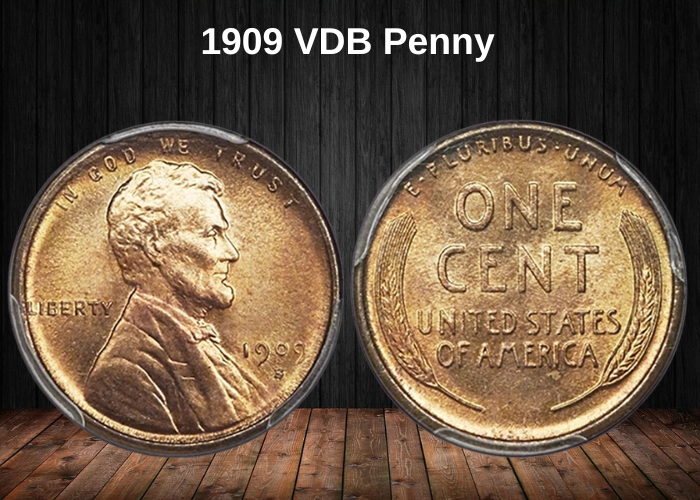
Abraham Lincoln served as the 16th president of the United States and is widely regarded as one of the nation’s most influential historical figures. His issuance of the Emancipation Proclamation on January 1, 1863, set the stage for the abolition of slavery, further solidifying his legacy.
Born on February 12, 1809, into a modest family, Lincoln overcame numerous obstacles to become president in March 1861. Tragically, his second term was cut short when he was assassinated on April 14, 1865.
To honor Lincoln’s 100th birthday, the U.S. Mint introduced the 1909 Lincoln Cent. The coin was designed by Victor D. Brenner, a skilled Lithuanian-born sculptor.
Brenner included his initials, “VDB,” at the bottom of the coin’s reverse. However, the size of the lettering sparked public backlash, with many arguing that it detracted from the coin’s design and historical significance.
The controversy led the U.S. Mint to remove the initials later that year. By the time the change was made, nearly 28 million pennies bearing the VDB initials had already been minted.
From 1909 to 1917, Lincoln pennies were struck without Brenner’s initials. The Mint eventually reinstated them in 1918, but this time they were smaller and positioned on the obverse.
Due to the initial controversy, collectors eagerly hoarded 1909 VDB pennies, believing they would become valuable over time. As we’ll explore, these coins remain a prized addition to any coin collection today.
Features of 1909 VDB Penny
The obverse of the 1909 VDB Penny
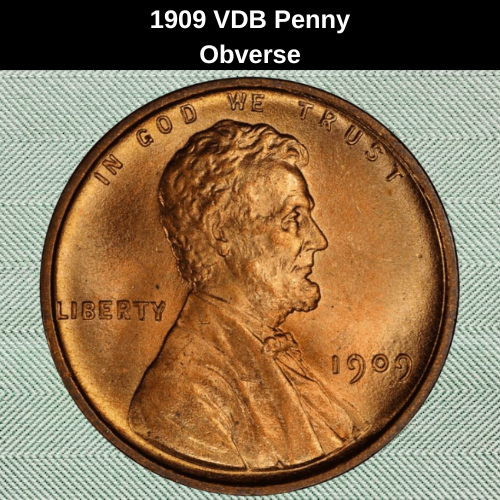
The obverse of the coin showcases a right-facing portrait of Abraham Lincoln. Designer Victor Brenner based this depiction on an image he had previously used for a desk plaque commissioned by a private client.
Encircling the top rim of the coin is the national motto, IN GOD WE TRUST. To the left of Lincoln’s portrait, the word LIBERTY is inscribed, while the year of issuance, 1909, is positioned to the right.
The Reverse of the 1909 VDB Penny
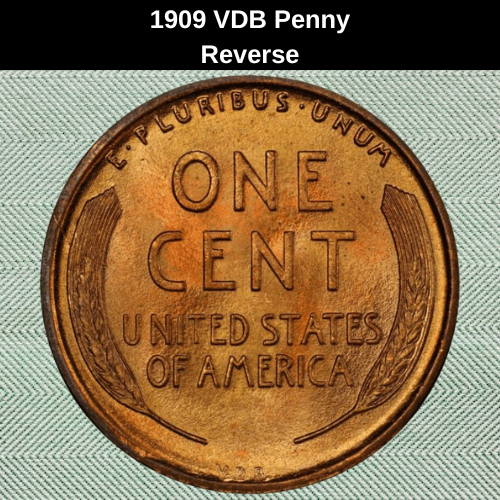
On the reverse side of the coin, two wheat stalks extend along the left and right edges, giving the Wheat Penny its distinctive name.
Centered between these wheat ears, the denomination ONE CENT is prominently displayed, followed by UNITED STATES OF AMERICA beneath it.
At the top rim of the coin, the national motto E PLURIBUS UNUM is inscribed.
Notably, the initials VDB, representing Victor D. Brenner, the coin’s designer, appear along the lower rim.
The first 28 million Lincoln pennies struck in 1909 featured these initials before they were removed, making them highly sought after by collectors today.
Other Features of the 1909 VDB Penny
The 1909 Lincoln penny is made of 95% copper, with the remaining 5% composed of zinc and tin.
It has a weight of 3.11 grams, a diameter of 19.00 millimeters, and a thickness of 1.4 millimeters. The coin features a smooth edge.
VDB pennies come in three color variations: red, brown, or red-brown. Mint-condition coins often retain their original bright red copper luster, while circulated pennies or those exposed to the elements tend to develop a brown or red-brown patina over time.
1909 VDB Penny Grading
When evaluating the 1909 VDB penny, two key factors come into play:
- Condition – Coins that have been circulated and show visible wear, dents, or scratches are graded lower and have a lower value. In contrast, uncirculated coins with a bright luster and sharp details are graded higher and are more valuable.
- Color – Red pennies tend to receive higher grades than red-brown or brown coins, making them more desirable and valuable among collectors.
Grading Scale for the 1909 VDB Penny
| Grade | Description |
|---|---|
| 1 | Basal State-1 |
| 2 | Fair |
| 3 | Very Fair |
| 4 – 6 | Good |
| 7 – 10 | Very Good |
| 12, 15 | Fine |
| 20, 30 | Very Fine |
| 40 | Extremely Fine |
| 50 | About Uncirculated |
| 60 | Mint State |
| 65 | Mint State (Gem) |
| 70 | Mint State (Perfect) |
To determine the exact value of your coin, it’s important to refer to grading guides and assess both its condition and color accurately.
1909 VDB Penny Value Guides
The 1909 VDB penny is highly sought after by collectors due to its controversial history and limited production before being removed from circulation.
Mint Varieties of the 1909 VDB Penny
Only two U.S. Mint facilities produced the VDB penny in 1909:
- Philadelphia Mint (1909 P VDB Penny)
- San Francisco Mint (1909 S VDB Penny)
- Philadelphia Mint Proof Version (1909 P Proof VDB Penny)
Additionally, the color of the penny plays a significant role in its value. The three primary color classifications are:
- Red (RD) – Most valuable
- Red-Brown (RB) – Mid-range value
- Brown (BN) – Least valuable
Now, let’s explore the value of each 1909 VDB penny variety in different conditions.
1909 P VDB Penny Value
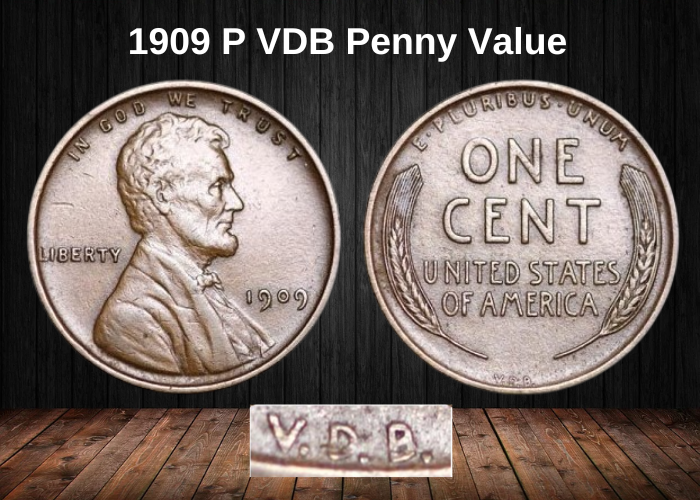
In 1909, the U.S. Mint produced approximately 27,995,000 Lincoln pennies with the VDB initials on the reverse to celebrate President Lincoln’s 100th anniversary.
Although most of these coins were circulated, many were hoarded during the VDB controversy, with people believing that the pennies would increase significantly in value over time.
Today, the 1909 VDB penny is one of the few coins still easily found in mint condition, despite originally being circulated currency.
Value Based on Color and Condition
- Red pennies are the most desirable, and even lower-graded examples can be worth more than their face value.
- A Red 1909 P VDB penny graded MS60 has a value of around $35.
- One graded MS65 can be worth up to $225.
- Brown pennies are less valuable, but still highly sought after in good condition.
- A Brown 1909 P VDB penny graded MS62 was sold for $4,830 in 2002.
- The highest-grade Red Brown pennies and Red pennies command premium prices:
- An MS68 Red Brown penny was sold for $22,800.
- A Red penny graded MS68 fetched an impressive $60,000.
1909 S VDB Penny Value
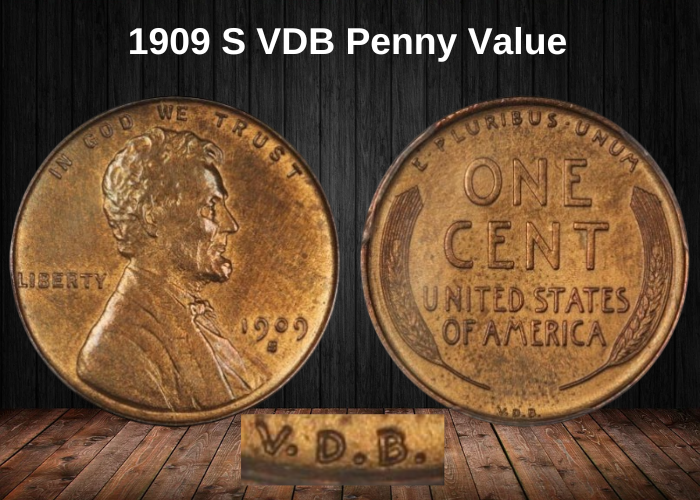
The 1909 S VDB penny is considered one of the 100 greatest U.S. coins and is highly regarded in the Lincoln penny series, making it a coveted coin among collectors.
When the U.S. Mint decided to remove the VDB initials, the San Francisco Mint had already produced 484,000 of these coins. This low mintage makes the 1909 S VDB penny quite rare and highly valuable.
Value Based on Condition
- A Very Fine (VF) 30 graded 1909 S VDB penny is valued at approximately $1,350.
- An About Uncirculated (AU) 50 graded coin is worth about $1,650.
High-Grade Values
- A brown 1909 S VDB penny in MS67 can reach up to $25,000.
- A red-brown coin can command an impressive $50,000.
- The most valuable is a red penny graded MS67, which can fetch around $175,000.
1909 P VDB Proof Penny Value
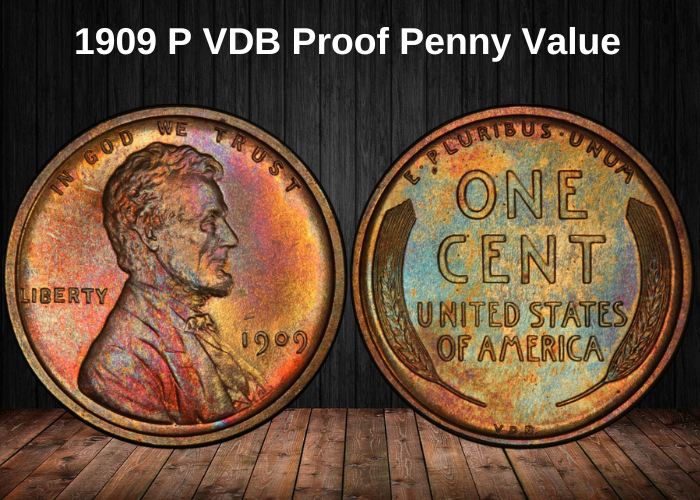
In addition to regular strike coins, the Philadelphia Mint produced proof coins for the 1909 VDB penny. The Mint uses special dies to strike proof coins, resulting in extra-shiny surfaces and pronounced designs compared to regular strike coins.
In 1909, only 1,194 Matte Proof Lincoln pennies were struck, making them the rarest Lincoln matte-proof coins between 1909 and 1916.
Identification Tips for Genuine 1909 VDB Lincoln Matte Proof Pennies:
- Look for square edges and sharp rims.
- Check for die markers under the R and T in the word LIBERTY, and at the back of Lincoln’s coat.
- You’ll also notice die scratches under Lincoln’s nose.
Value of 1909 VDB Matte Proof Pennies:
- A PF62 graded coin can be worth $10,500.
- A PF66 graded coin can fetch about $45,000.
Rare 1909 VDB Penny Error List
1909 VDB Double-Die Obverse Penny Error
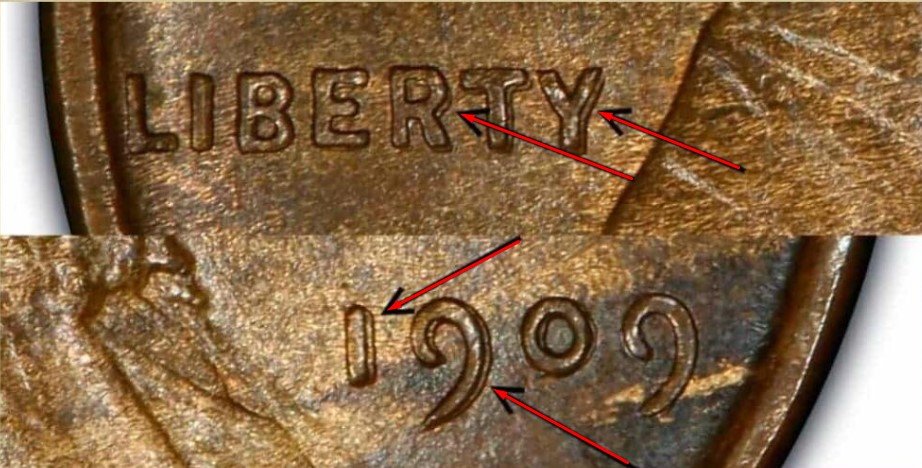
Double-die errors are a common type of minting mistake. This error occurs when the die used to strike the coin shifts slightly during the striking process, creating a double image effect on the design, figures, or letters on the coin.
In the case of the 1909 VDB penny, the double-die error is most visible on the word LIBERTY and the date of the coin, 1909.
Value of Double-Die 1909 VDB Pennies:
- A specimen with a double-die obverse error was auctioned for around $70.
- A Lincoln VDB penny with this error in mint state can fetch up to $1,500.
1909 VDB Offset Penny Error
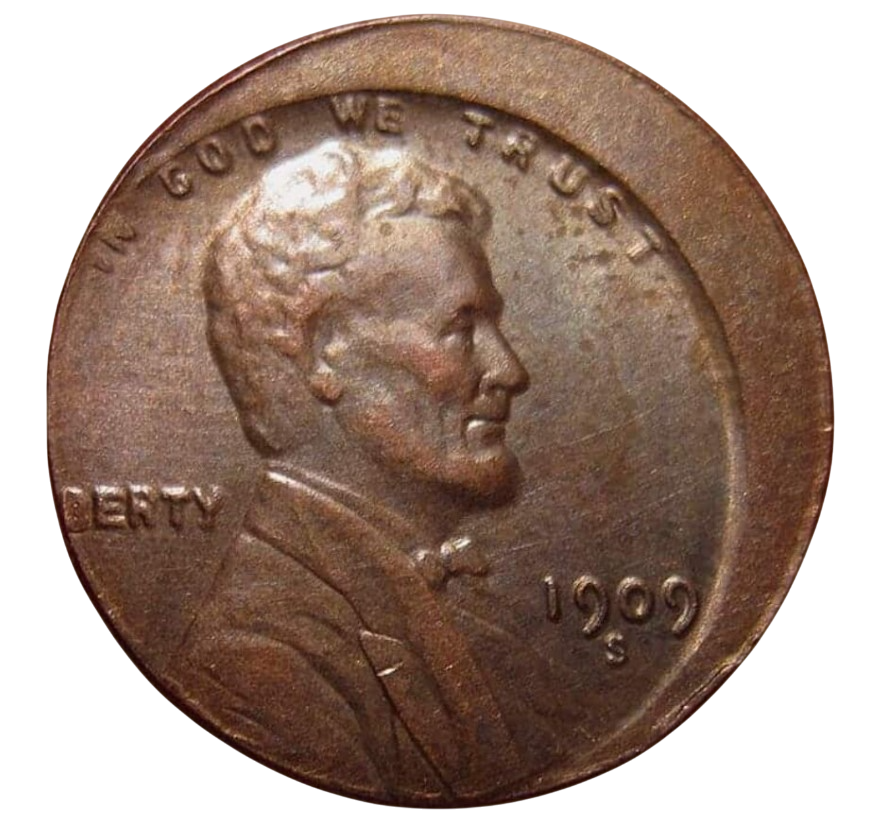
An offset error happens when the die used to strike the coin is not perfectly centered over the receiving anvil die. This causes the image on the obverse (front) of the coin to be off-center, while the reverse (back) remains centered.
In the case of the 1909 VDB penny, the offset error appears at the uppermost rim of the coin and also cuts off the L and I in LIBERTY, making it a particularly striking and noticeable error.
Value of Offset Error 1909 VDB Pennies:
- A specimen graded MS67 and sold in 2018 fetched $15,000.
FAQ
How much is a VDB 1909 penny worth?
The value of a 1909 VDB penny depends on its condition. In circulated condition, it’s worth around $12, but this can increase to $375 or more if the coin is in mint state.
How do you identify a 1909 VDB penny?
The most straightforward way to identify a 1909 VDB penny is by looking for the VDB initials on the reverse of the coin. The VDB initials on these pennies are significantly larger than those found on pennies struck after 1918.
What is the most expensive VDB penny?
The 1909 P VDB Proof penny is the rarest and most valuable in the Lincoln penny series. Only a few of these proof coins are accounted for, making them very hard to find. A 1909 P VDB Proof penny can fetch at least $150,000.













































